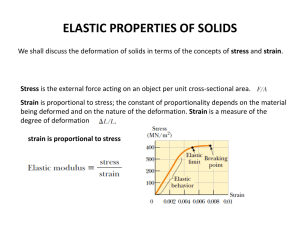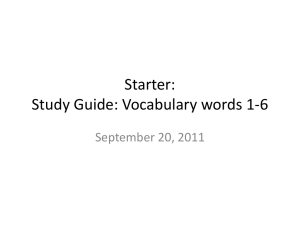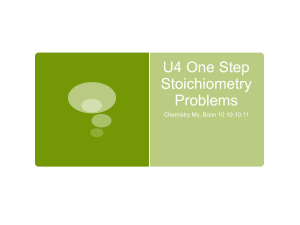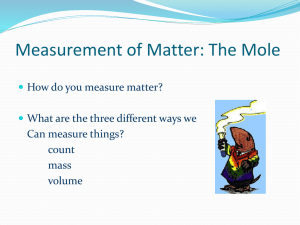CHAPTER 2
advertisement
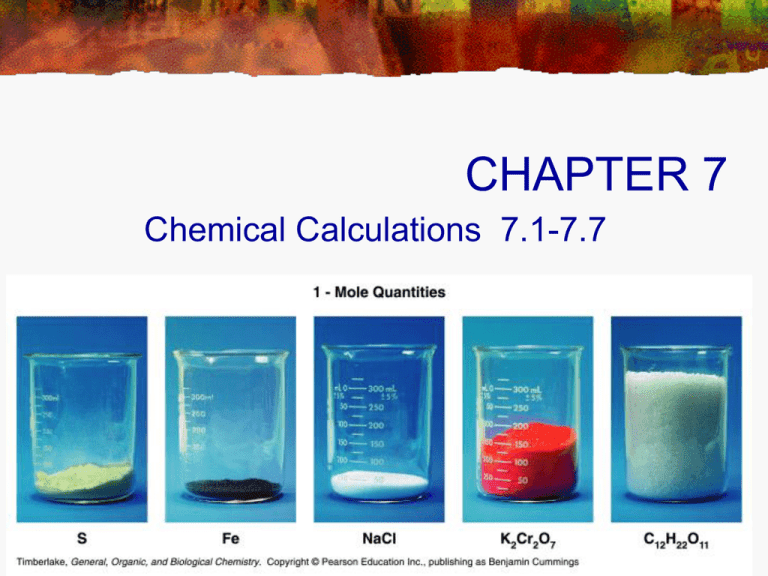
CHAPTER 7 Chemical Calculations 7.1-7.7 1 The Mole A number of atoms, ions, or molecules that is large enough to see and handle. A mole = number of things Avogadro’s number = 6.022 x 1023 2 Just like a dozen = 12 things One mole = 6.022 x 1023 things Symbol for Avogadro’s number is NA. The Mole 3 The Mole How do we know when we have a mole? Molar mass - mass in grams numerically equal to the atomic weight of the element in grams. H has an atomic weight of 1.00794 g 1.00794 g of H atoms = 6.022 x 1023 H atoms Mg has an atomic weight of 24.3050 g 4 count it out weigh it out 24.3050 g of Mg atoms = 6.022 x 1023 Mg atoms The Mole 5 The Mole 6 Example 2-1: Calculate the mass of a single Mg atom in grams to 3 significant figures. ? g Mg The Mole 7 Example 2-1: Calculate the mass of a single Mg atom in grams to 3 significant figures. ? g Mg 1 Mg atom The Mole Example 2-1: Calculate the mass of a single Mg atom in grams to 3 significant figures. 1 mol Mg atoms ? g Mg 1 Mg atom 23 6.022 10 Mg atoms 8 The Mole Example 2-1: Calculate the mass of a single Mg atom, in grams, to 3 significant figures. 1 mol Mg atoms ? g Mg 1 Mg atom 23 6.022 10 Mg atoms 24.30gMg 4.04 10 23 g Mg 1 mol Mg atoms 9 The Mole Example 2-2: Calculate the number of atoms in one-millionth of a gram of Mg to 3 significant figures. ? Mg atoms 10 The Mole 11 Example 2-2: Calculate the number of atoms in one-millionth of a gram of Mg to 3 significant figures. 1 mol Mg 6 ? Mg atoms 1.00 10 g Mg 24.30 g Mg The Mole Example 2-2: Calculate the number of atoms in one-millionth of a gram of Mg to 3 significant figures. ? Mg atoms 1.00 10 6 6.022 1023 Mg atoms 1 mol Mg atoms 12 1 mol Mg g Mg 24.30 g Mg The Mole Example 2-2: Calculate the number of atoms in one-millionth of a gram of Mg to 3 significant figures. 1 mol Mg ? Mg atoms 1.00 10 g Mg 24.30 g Mg 6 6.022 1023 Mg atoms 2.48 1016 Mg atoms 1 mol Mg atoms 13 The Mole Example 2-3. How many atoms are contained in 1.67 moles of Mg? ? Mg atoms 14 The Mole Example 2-3. How many atoms are contained in 1.67 moles of Mg? ? Mg atoms 1.67 mol Mg 15 The Mole Example 2-3. How many atoms are contained in 1.67 moles of Mg? 6.022 10 23 Mg atoms ? Mg atoms 1.67 mol Mg 1 mol Mg 16 The Mole Example 2-3. How many atoms are contained in 1.67 moles of Mg? 6.022 10 23 Mg atoms ? Mg atoms 1.67 mol Mg 1 mol Mg 1.00 10 24 Mg atoms 17 The Mole Example 2-3. How many atoms are contained in 1.67 moles of Mg? 6.022 1023 Mg atoms ? Mg atoms 1.67 mol Mg 1 mol Mg 1.00 1024 Mg atoms 18 The Mole 19 Example 2-4: How many moles of Mg atoms are present in 73.4 g of Mg? You do it! The Mole Example 2-4: How many moles of Mg atoms are present in 73.4 g of Mg? ? mol Mg 73.4 g Mg 20 The Mole Example 2-4: How many moles of Mg atoms are present in 73.4 g of Mg? 1 mol Mg atoms ? mol Mg 73.4 g Mg 24.30 g Mg 21 The Mole Example 2-4: How many moles of Mg atoms are present in 73.4 g of Mg? 1 mol Mg atoms ? mol Mg 73.4 g Mg 24.30 g Mg 3.02 mol Mg IT IS IMPERATIVE THAT YOU KNOW HOW TO DO THESE PROBLEMS 22 Formula Weights, Molecular Weights, and Moles How do we calculate the molar mass of a compound? add atomic weights of each atom The molar mass of propane, C3H8, is: 3 C 3 12.01 amu 36.03 amu 8 H 8 1.01 amu 8.08 amu Molar mass 23 44.11 amu Formula Weights, Molecular Weights, and Moles 24 The molar mass of calcium nitrate, Ca(NO3)2 , is: You do it! Formula Weights, Molecular Weights, and Moles 1 Ca 1 40.08 amu 40.08 amu 2 N 2 14.01 amu 28.02 amu 6 O 6 16.00 amu 96.00 amu Molar mass 25 164.10 amu Formula Weights, Molecular Weights, and Moles 26 One Mole of Cl2 or 70.90g C3H8 You do it! Contains 6.022 x 1023 Cl2 molecules 2(6.022 x 1023 ) Cl atoms Formula Weights, Molecular Weights, and Moles 27 One Mole of Cl2 or 70.90g C3H8 or 44.11 g Contains 6.022 x 1023 Cl2 molecules 2(6.022 x 1023 ) Cl atoms 6.022 x 1023 C3H8 molecules 3 (6.022 x 1023 ) C atoms 8 (6.022 x 1023 ) H atoms Formula Weights, Molecular Weights, and Moles Example 2-5: Calculate the number of C3H8 molecules in 74.6 g of propane. ? C3H8 molecules 74.6 g C3H8 28 Formula Weights, Molecular Weights, and Moles Example 2-5: Calculate the number of C3H8 molecules in 74.6 g of propane. ? C3 H 8 molecules 74.6 g C3 H 8 1 mole C3 H 8 44.11 g C3 H 8 29 Formula Weights, Molecular Weights, and Moles Example 2-5: Calculate the number of C3H8 molecules in 74.6 g of propane. ? C3H8 molecules 74.6 g C3H8 1 mole C3H8 6.022 1023 C3H8 molecules 44.11 g C3H8 44.11 g C3H8 30 Formula Weights, Molecular Weights, and Moles Example 2-5: Calculate the number of C3H8 molecules in 74.6 g of propane. ? C3 H 8 molecules 74.6 g C3 H 8 1 mole C3 H 8 6.022 10 23 C3 H 8 molecules 44.11 g C3 H 8 44.11 g C3H 8 24 1.02 10 molecules 31 Formula Weights, Molecular Weights, and Moles 32 Example 2-8. Calculate the number of O atoms in 26.5 g of Li2CO3. You do it! Formula Weights, Molecular Weights, and Moles Example 2-8. Calculate the number of O atoms in 26.5 g of Li2CO3. 1 mol Li 2 CO3 ? O atoms 26.5 g Li 2 CO3 73.8 g Li 2 CO3 6.022 10 23 form. units Li 2 CO3 3 O atoms 1 mol Li 2 CO3 1 formula unit Li 2 CO3 6.49 10 23 O atoms 33 Percent Composition 34 % composition = mass of an individual element in a compound divided by the total mass of the compound x 100% Determine the percent composition of C in C3H8. mass C %C 100% mass C3 H 8 3 12.01 g 100% 44.11 g 81.68% Percent Composition and Formulas of Compounds 35 What is the percent composition of H in C3H8? You do it! Percent Composition What is the percent composition of H in C3H8? mass H %H 100% mass C3 H 8 8 H 100% C3H 8 8 1.01 g 100% 18.32% 44.11 g or 36 18.32% 100% 81.68% Percent Composition Example 2-10: Calculate the percent composition of Fe2(SO4)3 to 3 significant figures. You do it! 37 Percent Composition Example 2-10: Calculate the percent composition of Fe2(SO4)3 to 3 sig. fig. 2 Fe 2 55.8 g % Fe 100% 100% 27.9% Fe Fe 2 (SO 4 ) 3 399.9 g 3 S 3 32.1 g %S 100% 100% 24.1% S Fe 2 (SO 4 ) 3 399.9 g 12 O 12 16.0 g % O 100% 100% 48.0% O Fe 2 (SO 4 ) 3 399.9 g Total 38 100% Percent Composition 39 Empirical and Molecular Formulas 40 Empirical Formula - smallest whole-number ratio of atoms present in a compound Molecular Formula - actual numbers of atoms of each element present in a molecule of the compound We determine the empirical and molecular formulas of a compound from the percent composition of the compound. Empirical And Molecular Formulas 41 Empirical Formulas Example 2-11: A compound contains 24.74% K, 34.76% Mn, and 40.50% O by mass. What is its empirical formula? Make the simplifying assumption that we have 100.0 g of compound. In 100.0 g of compound there are: 42 24.74 g of K 34.76 g of Mn 40.50 g of O Empirical Formulas 1 mol K ? mol K 24.74g K 0.6327mol K 39.10g K 43 Empirical Formulas 1 mol K ? mol K 24.74g K 0.6327mol K 39.10g K 1 mol Mn ? mol Mn 34.76g Mn 0.6327mol Mn 54.94g Mn 44 Empirical Formulas 1 mol K ? mol K 24.74g K 0.6327mol K 39.10g K 1 mol Mn ? mol Mn 34.76g Mn 0.6327mol Mn 54.94g Mn 1mol O ? mol O 40.50g O 2.531mol O 16.00g O obtain smallest whole number ratio 45 Empirical Formulas 1 mol K ? mol K 24.74g K 0.6327mol K 39.10g K 1 mol Mn ? mol Mn 34.76g Mn 0.6327mol Mn 54.94g Mn 1mol O ? mol O 40.50g O 2.531mol O 16.00g O obtain smallest whole number ratio for K 46 0.6327 1K 0.6327 for Mn 0.6327 1 Mn 0.6327 Empirical Formulas ? mol K 24.74 g K 1 mol K 0.6327 mol K 39.10 g K 1 mol Mn ? mol Mn 34.76 g Mn 0.6327 mol Mn 54.94 g Mn 1mol O ? mol O 40.50 g O 2.531 mol O 16.00 g O obtain smallest whole number ratio 0.6327 for K 1K 0.6327 47 0.6327 for Mn 1 Mn 0.6327 2.531 for O 4O 0.6327 thus the chemical formula is KMnO 4 Empirical Formulas 48 Example 2-12: A sample of a compound contains 6.541g of Co and 2.368g of O. What is empirical formula for this compound? You do it! Empirical Formulas Example 2-12: A sample of a compound contains 6.541g of Co and 2.368g of O. What is empirical formula for this compound? 1 mol Co ? mol Co 6.541 g Co 0.1110 mol Co 58.93 gCo 1mol O ? mol O 2.368 g O 0.1480 mol O 16.00 g O find smallest whole number ratio 49 Empirical Formulas Example 2-12: A sample of a compound contains 6.541g of Co and 2.368g of O. What is empirical formula for this compound? 0.1110 0.1480 for Co 1 Co for O 1.333O 0.1110 0.1110 multipy both by 3 to turn fraction to whole number 1 Co 3 3 Co 1.333 O 3 4 O Thus the compound' s formula is : Co3O 4 50 Molecular Formulas Example 2-13: A compound is found to contain 85.63% C and 14.37% H by mass. In another experiment its molar mass is found to be 56.1 g/mol. What is its molecular formula? short cut method 1 mol contains 56.1 g 85.63% is C and 14.37% is H 56.1 g 0.8563 48.0 g of C 56.1 g 0.1437 8.10 g of H 51 Determination of Molecular Formulas convert masses to moles 52 1 mol C 48.0 g of C 4 mol C 12.0 g C 1 mol H 8.10 g of H 8 mol H 1.01 g H Thus the formula is : C4 H8 Calculations Based on Chemical Equations 53 Calculations Based on Chemical Equations Fe2O3 + 3 CO 2 Fe + 3 CO2 Example 3-1: How many CO molecules are required to react with 25 formula units of Fe2O3? 3 CO molecules ? CO molecules= 25 formulaunits Fe2O3 1 Fe2O3 formulaunit 75 moleculesof CO 54 Calculations Based on Chemical Equations Example 3-2: How many iron atoms can be produced by the reaction of 2.50 x 105 formula units of iron (III) oxide with excess carbon monoxide? ? Fe atoms= 2.5010 formulaunits Fe2O3 5 55 Calculations Based on Chemical Equations Example 3-2: How many iron atoms can be produced by the reaction of 2.50 x 105 formula units of iron (III) oxide with excess carbon monoxide? ? Fe atoms= 2.5010 formulaunits Fe2O3 5 2 Fe atoms 1 formulaunits Fe2O3 56 Calculations Based on Chemical Equations Example 3-2: How many iron atoms can be produced by the reaction of 2.50 x 105 formula units of iron (III) oxide with excess carbon monoxide? ? Fe atoms= 2.5010 formulaunits Fe2O3 5 2 Fe atoms 5 5.0010 Fe atoms 1 formulaunits Fe2O3 57 Calculations Based on Chemical Equations Example 3-3: What mass of CO is required to react with 146 g of iron (III) oxide? 1 molFe2O3 ? g CO = 146g Fe2O3 159.7 g Fe2O3 58 Calculations Based on Chemical Equations Example 3-3: What mass of CO is required to react with 146 g of iron (III) oxide? 1 molFe2O3 3 molCO ? g CO = 146g Fe2O3 159.7 g Fe2O3 1 molFe2O3 59 Calculations Based on Chemical Equations Example 3-3: What mass of CO is required to react with 146 g of iron (III) oxide? 1 mol Fe2O3 3 molCO ? g CO = 146g Fe2O3 159.7 g Fe2O3 1 mol Fe2O3 28.0 g CO 76.8 g CO 1 molCO 60 Calculations Based on Chemical Equations Example 3-4: What mass of carbon dioxide can be produced by the reaction of 0.540 mole of iron (III) oxide with carbon monoxide? 3 molCO 2 ? g CO 2 0.540 molFe2O3 1 mol Fe2O3 61 Calculations Based on Chemical Equations Example 3-4: What mass of carbon dioxide can be produced by the reaction of 0.540 mole of iron (III) oxide with carbon monoxide? 3 molCO 2 44.0 g CO 2 ? g CO 2 0.540 mol Fe2O3 1 mol Fe2O3 1 molCO 2 62 Calculations Based on Chemical Equations Example 3-4: What mass of carbon dioxide can be produced by the reaction of 0.540 mole of iron (III) oxide with carbon monoxide? 3 mol CO 2 44.0 g CO 2 ? g CO 2 0.540 mol Fe 2 O 3 1 mol Fe 2 O 3 1 mol CO 2 = 71.3 g CO 2 63 Calculations Based on Chemical Equations 64 Example 3-5: What mass of iron (III) oxide reacted with carbon monoxide if the carbon dioxide produced by the reaction had a mass of 8.65 grams? You do it! Calculations Based on Chemical Equations Example 3-5: What mass of iron (III) oxide reacted with carbon monoxide if the carbon dioxide produced by the reaction had a mass of 8.65 grams? 1 molCO2 1mol Fe2O3 ? g Fe2O3 8.65g CO2 44.0g CO2 3 molCO2 159.7 g Fe2O3 10.5 g Fe2O3 1 mol Fe2O3 65 Calculations Based on Chemical Equations 66 Example 3-6: How many pounds of carbon monoxide would react with 125 pounds of iron (III) oxide? You do it! Calculations Based on Chemical Equations 454 g Fe2 O3 ? lb CO = 125lb Fe2 O3 1 lb Fe 2 O 3 1 mol Fe 2 O3 3 molCO 159.7 g Fe 2 O3 1 mol Fe2 O 3 28 g CO 1 lb CO 65.7 lb CO 1 mol CO 454 g CO 67 YOU MUST BE PROFICIENT WITH THESE TYPES OF PROBLEMS!!! Limiting Reactant Concept Kitchen example of limiting reactant concept. 1 packet of muffin mix + 2 eggs + 1 cup of milk 12 muffins 68 How many muffins can we make with the following amounts of mix, eggs, and milk? Limiting Reactant Concept 69 Mix Packets Eggs Milk 1 1 dozen 1 gallon limiting reactant is the muffin mix 2 1 dozen 1 gallon 3 1 dozen 1 gallon 4 1 dozen 1 gallon 5 1 dozen 1 gallon 6 1 dozen 1 gallon 7 1 dozen 1 gallon limiting reactant is the dozen eggs Limiting Reactant Concept Example 3-7: Suppose a box contains 87 bolts, 110 washers, and 99 nuts. How many sets, each consisting of one bolt, two washers, and one nut, can you construct from the contents of one box? 1 bolt 87 sets 55sets 110 washers 1 set 2 washers 99 sets 99 nuts1 set 1 nut 87 bolts1 set 70 the maximumnumber we can makeis 55 sets determinedby thesmallest number Limiting Reactant Concept Example 3-8: What is the maximum mass of sulfur dioxide that can be produced by the reaction of 95.6 g of carbon disulfide with 110. g of oxygen? CS2 3 O2 CO2 2 SO 2 71 Limiting Reactant Concept Example 3-8: What is the maximum mass of sulfur dioxide that can be produced by the reaction of 95.6 g of carbon disulfide with 110. g of oxygen? CS2 3 O2 CO2 2 SO 2 1 mol 72 3 mol 1 mol 2 mol Limiting Reactant Concept Example 3-8: What is the maximum mass of sulfur dioxide that can be produced by the reaction of 95.6 g of carbon disulfide with 110. g of oxygen? CS2 3 O 2 CO 2 2 SO 2 1 mol 3 mol 1 mol 2 mol 76.2 g 3(32.0 g) 44.0 g 2(64.1 g) 73 Limiting Reactant Concept Example 3-8: What is the maximum mass of sulfur dioxide that can be produced by the reaction of 95.6 g of carbon disulfide with 110. g of oxygen? Determine which mass makes the most product CS2 3 O2 CO2 2 SO 2 1 molCS2 ? molSO 2 95.6 g CS2 76.2g 74 Limiting Reactant Concept CS2 3 O 2 CO 2 2 SO 2 1 molCS2 ? molSO 2 95.6 g CS2 76.2g 2 molSO 2 64.1 g SO 2 161g SO 2 1 molCS2 1 molSO 2 75 Limiting Reactant Concept CS2 3 O 2 CO 2 2 SO 2 1 molCS2 2 molSO 2 64.1 g SO 2 ? molSO 2 95.6 g CS2 161g SO 2 76.2g 1 molCS2 1 molSO 2 1 molO 2 2 molSO 2 64.1 g SO 2 ? molSO 2 110 g O 2 147 g SO 2 32.0g O 2 3 molO 2 1 molSO 2 76 Which is limiting reactant? Limiting reactant is O2. What is maximum mass of sulfur dioxide? Maximum mass is 147 g. Percent Yields from Reactions Theoretical yield is calculated by assuming that the reaction goes to completion. Actual yield is the amount of a specified pure product made in a given reaction. 77 Determined from the limiting reactant calculation. In the laboratory, this is the amount of product that is formed in your beaker, after it is purified and dried. Percent yield indicates how much of the product is obtained from a reaction. actual yield % yield = 100% theoretical yield Percent Yields from Reactions Example 3-9: A 10.0 g sample of ethanol, C2H5OH, was boiled with excess acetic acid, CH3COOH, to produce 14.8 g of ethyl acetate, CH3COOC2H5. What is the percent yield? CH 3COOH + C2 H 5OH CH 3COOC2 H 5 H 2O 1. Calculate the theoretical yield 78 Percent Yields from Reactions CH 3COOH + C 2 H 5OH CH 3COOC2 H 5 H 2 O 1. Calculate the theoretical yield 88.0g CH 3COOC2 H 5 ? g CH 3COOC2 H 5 = 10.0g C 2 H 5OH 46.0 g C 2 H 5OH 19.1 g CH 3COOC2 H 5 79 Percent Yields from Reactions CH 3COOH + C 2 H 5OH CH 3COOC2 H 5 H 2 O 1. Calculat e t he t heoret ical yield 88.0g CH 3COOC2 H 5 ? g CH 3COOC2 H 5 = 10.0g C 2 H 5OH 46.0 g C 2 H 5OH 19.1 g CH 3COOC2 H 5 2. Calculat e t hepercentyield. 80 Percent Yields from Reactions CH 3COOH + C 2 H 5OH CH 3COOC2 H 5 H 2 O 1. Calculate the theoretical yield 88.0g CH 3COOC2 H 5 ? g CH 3COOC2 H 5 = 10.0g C 2 H 5OH 46.0 g C 2 H 5OH 19.1 g CH 3COOC2 H 5 2. Calculate thepercentyield. 14.8g CH 3COOC2 H 5 % yield = 100% 77.5% 19.1g CH 3COOC2 H 5 81


